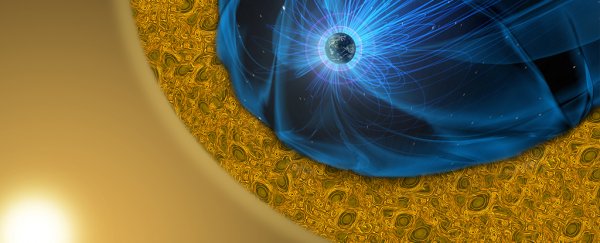NASA's Magnetospheric Multiscale (MMS) space weather mission has helped solve one of astrophysics' biggest questions – when a solar storm strikes our planet, where does its intense rain of energy go?
The discovery explains the behaviour of a chaotic zone at the edge of Earth's protective magnetic shell when it is showered with charged particles. In turn, the discovery lays fresh foundations for understanding similar turbulent hot-spots such as the one surrounding the Sun.
Astronomers found that there are sub-atomic scale shifts in the turbulent swirl of electrons far above our planet's surface that effectively dissipates the energy that gets caught up in its writhing mess of magnetism.
While most of us are familiar with the old-school diagram of a spherical cage of magnetic lines neatly surrounding our planet, a hairy scribble of magnetic fields also wraps around this calm bubble.
This messy zone of magnetism – called a magnetosheath – is somewhat like the white-capped swell of waves outside of the smooth currents of a lagoon, stretching out a distance equivalent to the diameter of the Earth several times over.
Further out still is a region called the bow shock, where the stream of solar wind slows down and bunches up as it enters our magnetic space.
Astronomers have studied the calmer 'lagoon' waters of our magnetosphere for decades, and have a fairly good understanding of how its magnetic lines carry charged particles.
But the wild waters in front of the bow shock have been far too choppy to get a good handle on, making it hard to accurately model how they channel the charged winds of plasma that blow in from the Sun.
"We know that magnetic energy in churning, turbulent systems cascades to smaller and smaller scales. At some point that energy is fully dissipated," says physicist James Drake from the University of Maryland.
"The big question is how that happens, and what role magnetic reconnection plays at such small scales."
Magnetic reconnection is the dramatic breaking and joining of opposing lines in a magnetic field, which releases showers of charged particles being channelled down their invisible pipelines.
Explosive surges of protons and electrons are known to release huge amounts of energy, putting any delicate electronic technologies in their path at risk.
It would make sense that similar surges play a role in soaking up a significant portion of the solar wind's energy as it spills from the bow shock.
Studying such reconnections in the magnetosphere is relatively easy thanks in part to the fact they produce long 'ion jets' involving chunky particles like hydrogen ions.
That wild west of a magnetosheath is not only chaotic, its snapping fields is awash with electrons, which are virtually impossible to directly measure from down here thanks to their vastly shorter range.
That's where MMS comes in.
The mission's four satellites orbit in a close-knit pyramid formation, mapping the zone's electron density on a millisecond timescale and providing a detailed description of their behaviour.
Sure enough, among the tightly knotted weaves of magnetic lines there was a whole lot of snapping and reconnecting, clearly evident in the movements of electrons.
"MMS discovered electron magnetic reconnection, a new process much different from the standard magnetic reconnection that happens in calmer areas around Earth," says the study's lead author Tai Phan, a space scientist from the University of California, Berkeley.
This clip below explains the research with some great visuals.
Having solid evidence of magnetic reconnection on this scale not only helps us understand our own surrounding space and better protect our technology (not to mention our astronauts' health), it can be applied to a whole array of astronomical phenomena.
"Turbulence occurs everywhere in space: on the Sun, in the solar wind, interstellar medium, dynamos, accretion disks around stars, in active galactic nuclei jets, supernova remnant shocks and more," says physicist Michael Shay of the University of Delaware.
The Sun's corona is hundreds of times hotter than the visible surface beneath, and so far nobody has come up with a convincing explanation. One possibility is explosive eruptions called 'nanoflares'.
Knowing more about how magnetic fields reconnect in this ultrahot zone might fill in the missing pieces that lead to a satisfactory answer.
NASA's upcoming Solar Probe mission intends to collect crucial data by sweeping through the star's corona.
This research was published in Nature.
